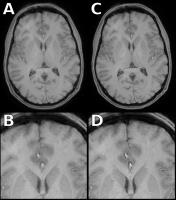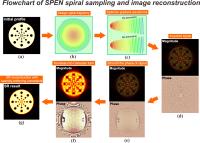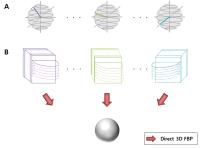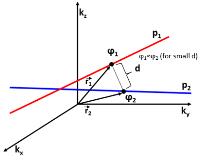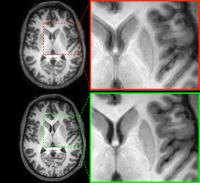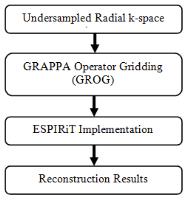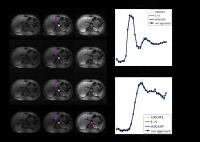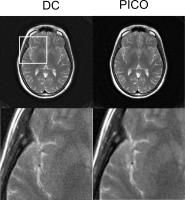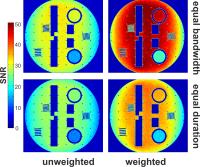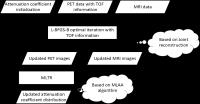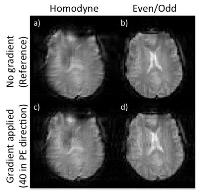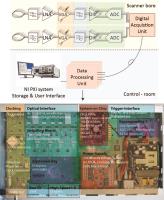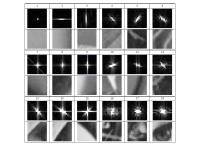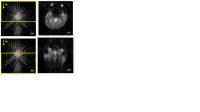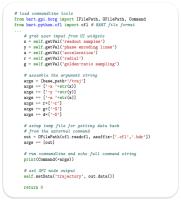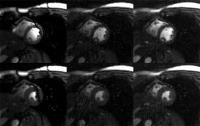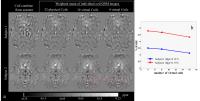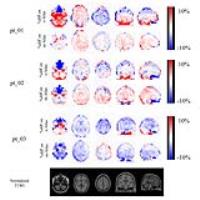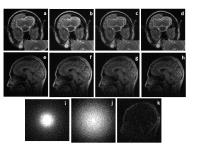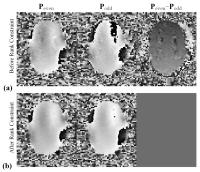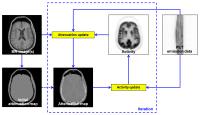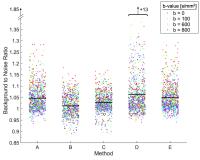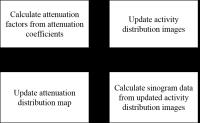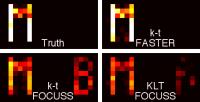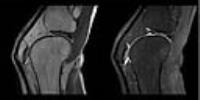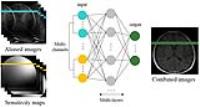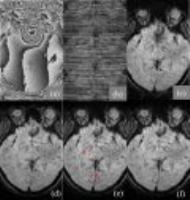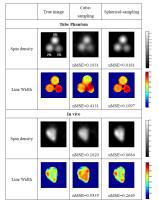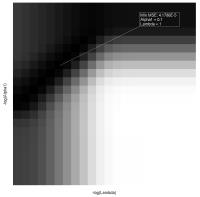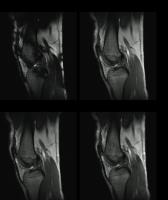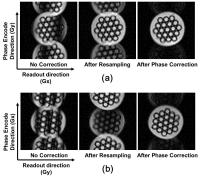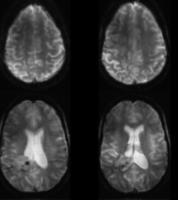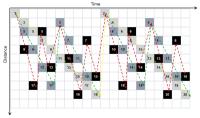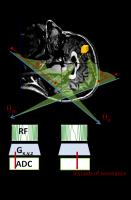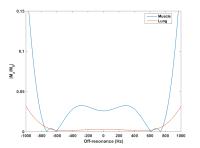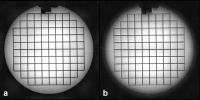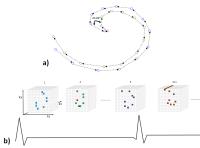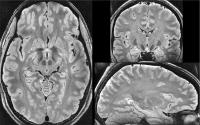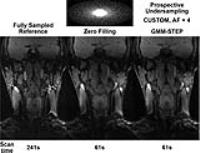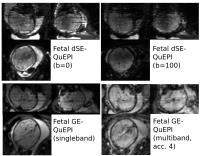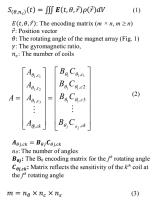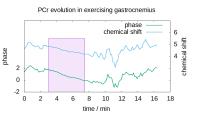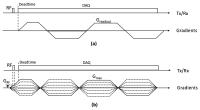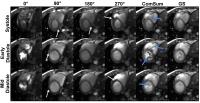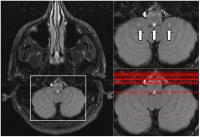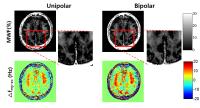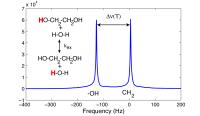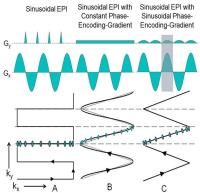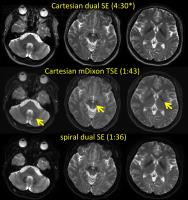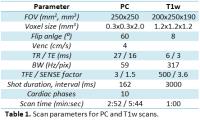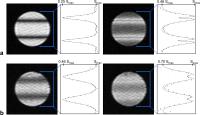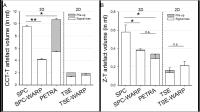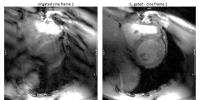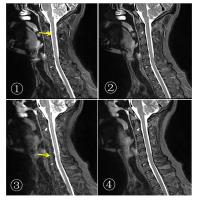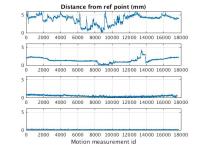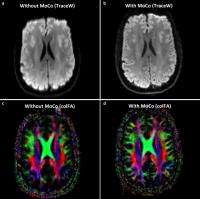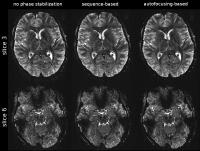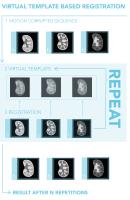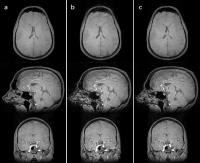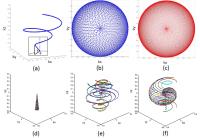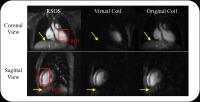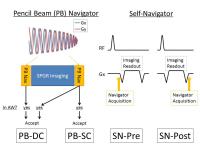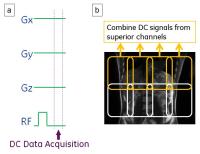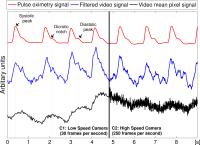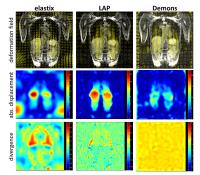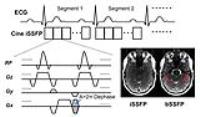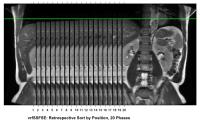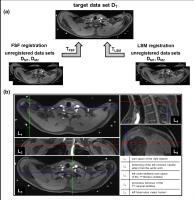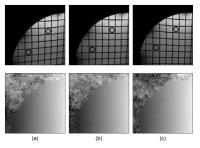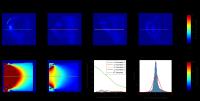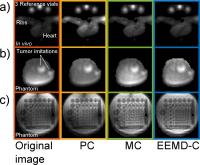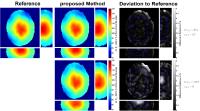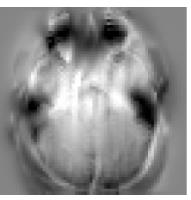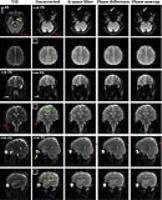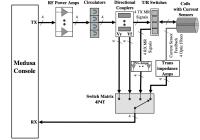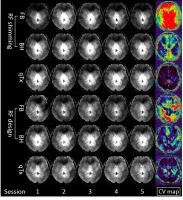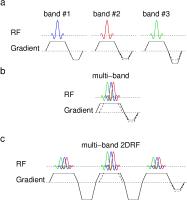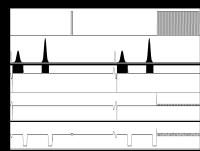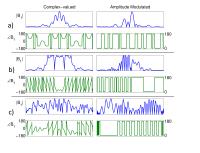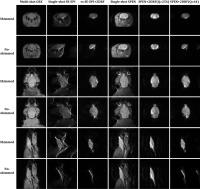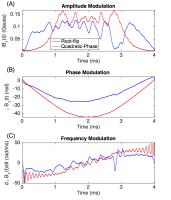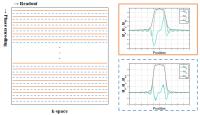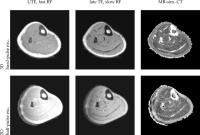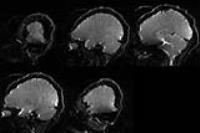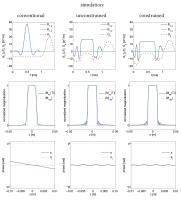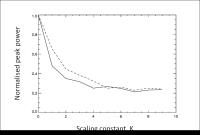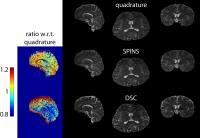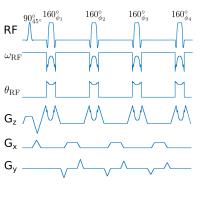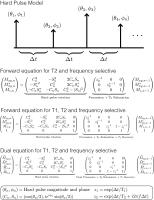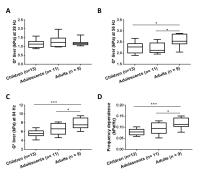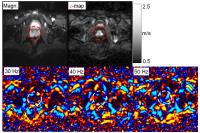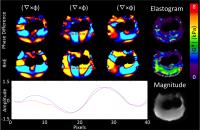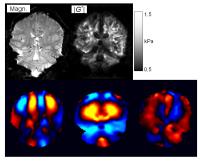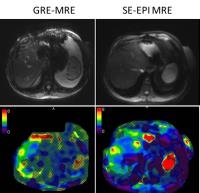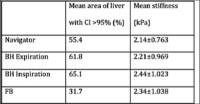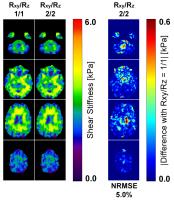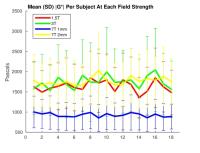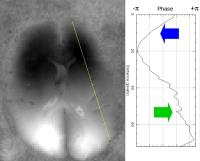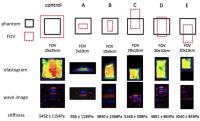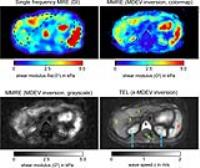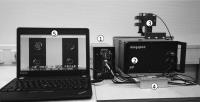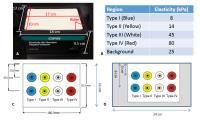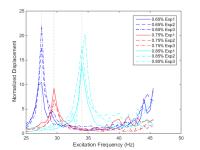|
1896.
 |
Simultaneous Estimation of Proton Densities and Receiver Coil
Sensitivities using Optimized Basis Functions 
Dietmar Cordes1,2, Zhengshi Yang1,
Xiaowei Zhuang1, Karthik Sreenivasan1,
and Le Hanh Hua1
1Cleveland Clinic Lou Ruvo Center for Brain
Health, Las Vegas, NV, United States, 2Department
of Psychology and Neuroscience, University of Colorado,
Boulder, CO, United States
In this study, a new algorithm to better model the receiver
coil sensitivities with the purpose of obtaining unbiased
proton density maps is proposed. Using optimized orthonormal
basis functions for the modeling produces an accurate fit of
potential inhomogeneities of the signal due to receiver coil
bias. The obtained final image of the proton density has low
variance, suitable for quantitative diagnostic information
of brain tissue. Results are shown for nine MS patients and
one control subject.
|
|
1897.
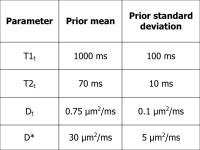 |
Multidimensional Diffusion and Relaxation Data Acquisition for
Improved Intravoxel Incoherent Motion Analysis 
Anna Scherman Rydhög1, André Ahlgren1,
Freddy Ståhlberg1,2,3, Ronnie Wirestam1,
and Linda Knutsson1
1Department of Medical Radiation Physics, Lund
University, Lund, Sweden, 2Department
of Diagnostic Radiology, Lund University, Lund, Sweden, 3Lund
Bioimaging Center, Lund University, Lund, Sweden
Intravoxel Incoherent Motion (IVIM) is a method for
quantification of perfusion parameters, such as the
perfusion fraction Fb. Unfortunately, CSF partial volume
effects are often seen in the estimated blood compartment.
This work introduces a novel version of the IVIM model,
containing three compartments (tissue, CSF and blood), where
multi-TE and multi-TI data are incorporated to yield a
direct relaxation estimate. Using this
relaxation-compensated model, results were obtained from in
vivo measurements in a volunteer. Compared to a
non-relaxation-compensated model, the three-compartment
model with relaxation-compensated data reduced the CSF
contamination.
|
|
1898.
 |
7TAMIbrainT1w_30 : Whole-brain ultra-high resolution average
T1-weighted template at 7 Tesla to improve in vivo depiction of
small brain structures 
Pierre Besson1,2,3, Arnaud Le Troter1,2,
Julien Sein1,2, Gilles Brun1,2, Maxime
Guye1,2, and Jean-Philippe Ranjeva1,2
1Aix-Marseille Université, CNRS, Centre de
Résonance Magnétique Biologique et Médicale (CRMBM) UMR
7339, Marseilles, France, 2APHM,
Timone Hospital, Pôle d’Imagerie, Centre d’Exploration
Métabolique par Résonance Magnétique (CEMEREM), Marseilles,
France, 3Siemens
Healthcare, St Denis, France
UHF 7T MR scanners offers the possibility to acquire very
high resolution in-vivo images, providing a new insight into
human brain structural characterization. Nevertheless, in
order to obtain highly contrasted and highly spatially
resolved atlas, and to compensate for the drop in SNR
related to reduction of the voxel size, averaging data among
several subjects is needed. We present in this abstract an
automatic pipeline that generates a whole
brain high-resolution T1-weighted template (called
7TAMIbrainT1w_30) built from MP2RAGE acquisitions obtained
in 30 healthy controls at 7T.
|
|
1899.
 |
Complete partial volume solution for ASL brain perfusion data
applied to relapsing-remitting multiple sclerosis patients
Ruth Oliver1,2, Linda Ly1,2, Chenyu
Wang1,2, Heidi Beadnall2, Ilaria
Boscolo Galazzo3,4, Michael Chappell5,6,
Xavier Golay7, Enrico De Vita7, David
Thomas7, and Michael Barnett1,2
1Sydney Neuroimaging Analysis Centre, Sydney,
Australia, 2University
of Sydney, Sydney, Australia, 3Institute
of Nuclear Medicine, University College London, London,
United Kingdom, 4Department
of Neuroradiology, University Hospital Verona, Verona,
Italy, 5Institute
of Biomedical Engineering, University of Oxford, Oxford,
United Kingdom, 6FMRIB
Centre, University of Oxford, Oxford, United Kingdom, 7Institute
of Neurology, University College London, London, United
Kingdom
ASL is a low resolution imaging modality that suffers from
the partial volume effect, leading to an underestimation of
GM perfusion. This effect has two principle causes; blurring
from the point spread function in the slice direction, and
inadequate resolution due to the need for large voxels to
achieve sufficient SNR. Both may act as confounders for
measurement of GM CBF abnormalities. Decreased GM perfusion
could reflect neuronal loss or metabolic dysfunction; PV
correction allows a decoupling of structure and function. We
present the first application of a complete PV correction
solution for ASL to a cohort of MS patients.
|
|
1900.
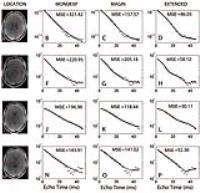 |
Anomalous relaxation in the human brain mapped using ultra-high
field magnetic resonance imaging and time-fractional Bloch
equation
Shanlin Qin1, Fawang Liu1, Ian William
Turner1,2, Qiang Yu3, Qianqian Yang1,
and Viktor Vegh3
1School of Mathematical Sciences, Queensland
University of Technology, Brisbane, Australia, 2ARC
Centre of Excellence for Mathematical and Statistical
Frontiers, Melbourne, Australia, 3Centre
for Advanced Imaging, University of Queensland, Brisbane,
Australia
MRI models based on integer order calculus lack the ability
to accurately map magnitude signal decay in the human brain,
likely due to magnetic susceptibility and microstructure
variations in tissues. We applied fractional calculus to the
Bloch equation with the aim of developing a model capable of
matching experimental findings. Solution of the
time-fractional Bloch equation resulted in a new five
parameter model. We analysed model parameters in nine brain
regions using multiple echo gradient recalled echo MRI data
from five participants. Time-fractional model parameters may
provide new ways of studying microstructure and
susceptibility induced changes in the human brain.
|
|
1901.
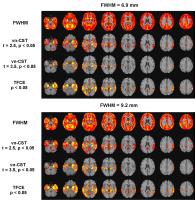 |
Evaluation the cluster-size inference with random field and
permutation methods for group-level MRI analysis
Huanjie Li1, Lisa D. Nickerson2, Yang
Fan3, Thomas E. Nichols4, and Jia-Hong
Gao5
1Department of Biomedical Engineering, Dalian
University of Technology, Dalian, China, People's Republic
of, 2McLean
Imaging Center, McLean Hospital/Harvard Medical School,
Belmont, MA, United States, 3GE
Healthcare, MR Research China, Beijing, China, People's
Republic of, 4Department
of Statistics and Warwick Manufacturing Group, University of
Warwick, Coventry, United Kingdom, 5Center
for MRI Research, Peking University, Beijing, China,
People's Republic of
Threshold-free cluster enhancement (TFCE) outperforms the
cluster-size test (CST) based on random field theory and our
recent papers provide two voxelation-corrected CST (v-CST
and vn-CST) which also show the clear advantage over other
CST as well. However, it’s not clear which one shows better
performance for MRI data analysis. This work provides a very
careful, fair and thorough evaluation of the powerful
statistical methods, which may be particularly appealing
for group-level MRI data analysis.
|
|
1902.
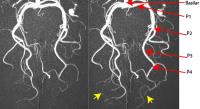 |
Arterial segmentation and visual stimulus-induced changes in
diameter observed in the human brain 
Alexandre Bizeau1,2, Guillaume Gilbert3,
Minh Tung Huynh4, Michaël Bernier1,2,
Christian Bocti5, Maxime Descoteaux2,6,
and Kevin Whittingstall1,2,4
1Department of Radiation Sciences and Biomedical
imagery, Université de Sherbrooke, Sherbrooke, QC, Canada, 2Centre
d’Imagerie Moléculaire de Sherbrooke (CIMS), Centre de
Recherche CHUS, Sherbrooke, QC, Canada, 3MR
Clinical Science, Philips Healthcare, Markham, ON, Canada, 4Department
of Diagnostic Radiology, Université de Sherbrooke,
Sherbrooke, QC, Canada, 5Department
of Medecine, Université de Sherbrooke, Sherbrooke, QC,
Canada, 6Department
of Computer Science, Université de Sherbrooke, Sherbrooke,
QC, Canada
When undergoing stimulation, neurons need to be supplied
with oxygen and glucose. This demand then induces
vasodilation generated by the astrocytes which act on the
muscles of the arteries of the human brain. Using
time-of-flight magnetic resonance angiography acquisitions,
we extracted the apparent diameter of arterial vessels. We
then compared diameter with and without visual stimulation
and demonstrated that smaller vessels dilate proportionally
more than larger ones in the posterior cerebral arteries.
Using this method, the investigation of the coupling between
neural activity and regional cerebral vasodilation, also
called functional hyperhemia, is now possible.
|
|
1903.
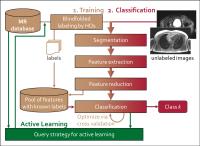 |
An Active Learning platform for automatic MR image quality
assessment 
Thomas Küstner1,2, Martin Schwartz1,2,
Annika Kaupp2, Petros Martirosian1,
Sergios Gatidis1, Nina F. Schwenzer1,
Fritz Schick1, Holger Schmidt1, and
Bin Yang2
1University Hospital Tübingen, Tübingen, Germany, 2Institute
of Signal Processing and System Theory, University of
Stuttgart, Stuttgart, Germany
Acquired images are usually analyzed by a human observer
(HO) according to a certain diagnostic question. Flexible
algorithm parametrization and the enormous amount of data
created per patient make this task time-demanding and
expensive. Furthermore, definition of objective quality
criterion can be very challenging, especially in the context
of a missing reference image. In order to support the HO in
assessing image quality, we propose a non-reference MR image
quality assessment system based on a machine-learning
approach with an Active Learning loop to reduce the amount
of necessary labeled training data. Labeling is performed
via an easy accessible website.
|
|
1904.
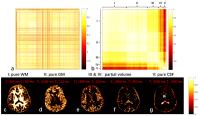 |
Brain Tissue Clustering Based on Cross-Correlation of Magnetic
Resonance Fingerprinting
Mu Lin1, Xiaozhi Cao1, Congyu Liao1,
Xu Yan2, and Jianhui Zhong1
1Center for Brain Imaging Science and Technology,
Zhejiang University, Hangzhou, China, People's Republic of, 2MR
Collaboration NE Asia, Siemens Healthcare, Hangzhou, China,
People's Republic of
Multi-component tissue model with priori T1 and
T2 have
been used to decompose MRF data. We propose that tissue
classification can be improved when the selection uses
clustering method based on cross-correlation. Our results
from phantom and in vivo measurements show that the method
successfully separates signal from different tissue types,
allows extraction of tissue fractions, and results are more
robust with image quality.
|
|
1905.
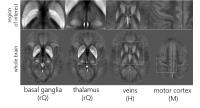 |
Toward a voxel-based analysis (VBA) of quantitative magnetic
susceptibility maps (QSM): Strategies for creating brain
susceptibility templates 
Jannis Hanspach1, Michael G Dwyer1,
Niels P Bergsland1,2, Xiang Feng3,
Jesper Hagemeier1, Paul Polak1, Nicola
Bertolino1, Jürgen R Reichenbach3,4,
Robert Zivadinov1,5, and Ferdinand Schweser1,5
1Buffalo Neuroimaging Analysis Center, Department
of Neurology, Jacobs School of Medicine and Biomedical
Sciences, The State University of New York at Buffalo,
Buffalo, NY, United States, 2MR
Research Laboratory, IRCCS Don Gnocchi Foundation ONLUS,
Milan, Italy, 3Medical
Physics Group, Department of Diagnostic and Interventional
Radiology, Jena University Hospital - Friedrich Schiller
University Jena, Jena, Germany,4Michael Stifel
Center for Data-driven and Simulation Science Jena,
Friedrich Schiller University Jena, Jena, Germany, 5MRI
Molecular and Translational Research Center, Jacobs School
of Medicine and Biomedical Sciences, The State University of
New York at Buffalo, Buffalo, NY, United States
Quantitative susceptibility mapping (QSM) is a recent in
vivo magnetic resonance imaging (MRI) technique that
provides quantitative information about the bulk magnetic
susceptibility distribution in tissues, a promising measure
for studying brain iron. A voxel-based analysis (VBA) of
susceptibility maps would facilitate a better understanding
of the intricate anatomical structure (e.g. sub-nuclear
regions) of deep gray matter and its relation to diseases
and normal aging. In the present work, we developed and
quantitatively assessed six strategies for creating a
susceptibility brain template for VBA based on ANTs,
representing the first step toward an understanding of
sub-nuclear susceptibility changes without the need for a
priori information.
|
|
1906.
 |
Automated multi-parametric segmentation of brain veins from GRE
acquisition 
Serena Monti1,2, Pasquale Borrelli1,
Sirio Cocozza3, Sina Straubb4, Mark
Ladd4, Marco Salvatore1, Enrico
Tedeschi3, and Giuseppe Palma5
1IRCCS SDN, Naples, Italy, 2Department
of Electronics, Information and Bioengineering, Politecnico
di Milano, Milan, Italy, 3Department
of Advanced Biomedical Sciences, University "Federico II",
Naples, Italy,4Department of Medical Physics in
Radiology, German Cancer Research Center (DKFZ), Heidelberg,
Germany, 5Institute
of Biostructure and Bioimaging, National Research Council,
Naples, Italy
A new fully automated algorithm, based on structural,
morphological and relaxometric information, is proposed to
segment the entire brain deep venous system from MR images.
The method is tested on brain datasets at different magnetic
fields and its inter-scan reproducibility is also assessed.
The proposed segmentation algorithm shows good accuracy and
reproducibility, outperforming previous methods and becoming
a promising candidate for the characterization of venous
tree topology.
|
|
1907.
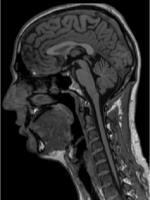 |
Human Head Models from MRI for Head Impact Analysis
Yash Agarwal1, Philippe Young1, Ross
Cotton1, Chris Pearce2, Siddiq Qidwai3,
Amit Bagchi3, and Nithyanand Kota3
1Simpleware Ltd., Exeter, United Kingdom, 2Atkins,
Epsom, United Kingdom, 3U.S.
Naval Research Laboratory, Washington, DC, United States
Image-based model generation methods demonstrate the value
of creating realistic human head models based on
high-resolution MRI data. Head models created by the U.S.
Naval Research Laboratory and Simpleware (Exeter, UK) are
being used to study head impact and traumatic brain injury;
this offers a solution to the problem of limited
experimental testing. Results from the modelling methodology
and simulation demonstrate a good level of accuracy when
compared to experimental benchmarks. The methodology and
models have been extended for use in areas such as examining
head impact in sports including American football, rugby and
cricket.
|
|
1908.
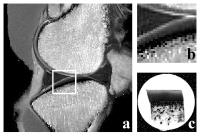 |
Improve the Detection of Cartilage Degradation by Dividing the
Tissue Unequally – A Comparative Study of Two Methods 
Farid Badar1, Ji Hyun Lee1, and Yang
Xia1
1Department of Physics and Center for Biomedical
Research, Oakland University, Rochester, MI, United States
The consequences of two different zone-division methods in
MRI T2 of articular cartilage were studied, using an animal
model of early osteoarthritis (OA). By dividing the
cartilage thickness unequally, significant improvement in OA
detection can be achieved – both in the deeper cartilage as
well as between the contralateral and normal tissue. This
improved detection may become important in the clinical
diagnostics of early OA.
|
|
1909.
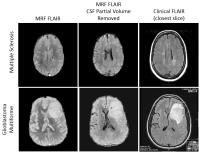 |
Accurate Synthetic FLAIR Images Using Partial Volume Corrected
MR Fingerprinting 
Anagha Deshmane1, Debra McGivney2,
Chaitra Badve3, Alice Yu4, Yun Jiang1,
Dan Ma2, and Mark Griswold1,2
1Biomedical Engineering, Case Western Reserve
University, Cleveland, OH, United States, 2Radiology,
Case Western Reserve University, Cleveland, OH, United
States, 3Radiology,
University Hospitals of Cleveland, Cleveland, OH, United
States, 4School
of Medicine, Case Western Reserve University, Cleveland, OH,
United States
Synthetic weighted images from quantitative parameter maps
suffer from partial volume artifacts which can distort
contrast. In this work, Partial Volume MR Fingerprinting is
applied to estimate and remove signal due to cerebrospinal
fluid (CSF) in the brain, allowing for improved contrast in
synthetic FLAIR images generated from MRF relaxation time
maps.
|
|
1910.
 |
Improvement in Glioma Visualization using Subtraction Maps
Derived from Contrast-Enhanced T1- and T2-Weighted MR Images
Mohammed Goryawala1, Bhaswati Roy2,
Rakesh K Gupta2, and Andrew A Maudsley1
1Department of Radiology, University of Miami,
Miami, FL, United States, 2Department
of Radiology, Fortis Memorial Research Institute, Gurgaon,
India
Calculated differences between two images of differing T1 or
T2 contrasts, or subtraction images, have been presented as
a way to improve image contrast for imaging of brain tumors.
In this study the performance of subtraction images for
differentiation of tumor, edema, and normal appearing white
matter (NAWM) is compared to traditionally acquired anatomic
MRIs, diffusion tensor imaging (DTI), perfusion weighted
imaging (PWI) and MR spectroscopy imaging (MRSI). Results
showed a significant increase in contrast for
differentiating between enhancing tumor and edematous
regions from NAWM using the ΔT1 map and ΔT2 map,
respectively, as compared to other parametric maps.
|
|
1911.
 |
Resource-efficient architecture of FPGA-based 2D FFT processors 
Limin Li1 and
Alice M Wyrwicz1,2
1Center for Basic MR Research, Northshore
University Healthsystem, Evanston, IL, United States, 2Department
of Biomedical Engineering, Northwestern University,
Evanston, IL, United States
The processing rate for real-time multi-slice image
reconstruction on an FPGA can be improved significantly by
taking advantage of its parallel processing capability. In
particular, multiple 2D FFT processors can be embedded into
a single FPGA and run simultaneously. In this abstract, we
report a new design of a 2D FFT processor with significant
reduced usage of hardware resource. Test results show that
an important type of resource, DSP48 slice, can be reduced
by up to 50% without degrading processing performance, which
implies that more 2D FFT cores can be installed into a
single FPGA with a given size.
|
|
1912.
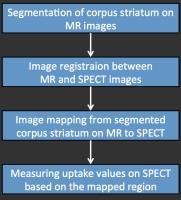 |
Quantitative image analysis based on Image registration of brain
MR and SPECT for dopamine transporter imaging
Takeshi Hara1, Yuta Takeda1, Tetsuro
Katafuchi2, Taiki Nozaki3, Masaki
Matsusako3, and Hiroshi Fujita1
1Intelligent Image Information, Gifu University
Graduate School of Medicine, Gifu, Japan, 2Health
Science, Gifu University of Medical Science, Seki, Japan, 3Radiology,
St. Luke's International Hospital, Tokyo, Japan
Features in Parkinson's disease (PD) are a degeneration and
loss of the dopamine neurons in striatum. 123I-FP-CIT can
visualize the distribution by binding to the dopamine
neurons. The radioactivated medicine is used for diagnosis
of PD and Dementia with Lewy Bodies (DLB). The material can
visualize activities in corpus striatum on SPECT images, but
the location of the corpus striatum on SPECT images are
often lost because of the low uptake. To realize a
quantitative image analysis for the SPECT images, image
registration technique to determine the region of corpus
striatum on SPECT images are required to measure precise
uptakes. In this study, we proposed an image fusion
technique for SPECT and MR images by intervening CT image
taken by SPECT/CT. We employed 30 cases of SPECT/CT and MR
cases for the evaluation. 25 of 30 cases were registered
correctly with registration errors less than 5mm. These
results enable to measure precise uptake on SPECT images
based on the segmentation results on MR images.
|
|
1913.
 |
Incorporation of Nonzero Echo Times in the SPGR and bSSFP Signal
Models used in mcDESPOT
Mustapha Bouhrara1 and
Richard G. Spencer1
1NIA, NIH, Baltimore, MD, United States
Formulations of the two-component spoiled gradient recalled
echo (SPGR) and balanced steady-state free precession
(bSSFP) models that incorporate nonzero echo time (TE)
effects are presented in the context of mcDESPOT and
compared with the conventionally used SPGR and bSSFP models
which ignore nonzero TEs. Relative errors in derived
parameter estimates from conventional mcDESPOT, omitting TE
effects, are assessed using simulations over a wide range of
experimental and sample parameters. The neglect of nonzero
TE leads to an overestimate of the SPGR and an underestimate
of the bSSFP signals. These effects introduce large errors
in parameter estimates derived from conventional mcDESPOT.
|
|
1914.
 |
A noise correction model incorporating weighted neighborhood
information for liver R2* mapping 
Changqing Wang1,2,3, Xinyuan Zhang2,
Yanying Ma4, Xiaoyun Liu1, Diego
Hernando3, Scott B. Reeder3,5,6,7,8,
Wufan Chen1,2, and Yanqiu Feng2
1School of Automation Engineering, University of
Electronic Science and Technology of China, Chengdu, China,
People's Republic of, 2School
of Biomedical Engineering and Guangdong Provincial Key
Laboratory of Medical Image Processing, Southern Medical
University, Guangzhou, China, People's Republic of, 3Radiology,
University of Wisconsin-Madison, Madison, WI, United States, 4School
of Mathematical Sciences, University of Electronic Science
and Technology of China, Chengdu, China, People's Republic
of, 5Medical
Physics, University of Wisconsin-Madison, Madison, WI,
United States, 6Biomedical
Engineering, University of Wisconsin-Madison, Madison, WI,
United States, 7Medicine,
University of Wisconsin-Madison, Madison, WI, United States, 8Emergency
Medicine, University of Wisconsin-Madison, Madison, WI,
United States
R2* mapping has the potential to provide rapid and accurate
quantification of liver iron overload. However, conventional
voxelwise liver R2* mapping methods are challenging when
using echo images with low signal-noise ratio (SNR). The
purpose of this work was to improve liver R2* mapping by a
noise correction model incorporating weighted neighborhood
information. Simulation and in vivo results demonstrate that
the proposed method produces more accurate R2* maps with
high spatial resolution compared to two recently proposed
R2* mapping methods.
|
|
1915.
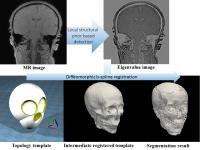 |
Automatic MR-based Skull Segmentation using Local Shape and
Global Topology Priors
Max W.K. Law1, Calvin M.H. Lee1,
Gladys G. Lo2, Jing Yuan1, Oilei Wong1,
Abby Y. Ding1, and Siu Ki Yu1
1Medical Physics and Research Department, Hong
Kong Sanatorium & Hospital, Hong Kong, Hong Kong, 2Department
of Diagnostic and Interventional Radiology, Hong Kong
Sanatorium & Hospital, Hong Kong, Hong Kong
This abstract proposes a new algorithm that automatically
segments the skull from gradient echo based magnetic
resonance images to facilitate MR-based radiotherapy
planning. The proposed algorithm compared the neighboring
voxel intensity to capture local structural information of
bone. The structural information was incorporated in a
topology template which encapsulated global topology prior
of skulls to achieve automatic segmentation. With the
sequence-independent structural and topology priors, this
method is potentially applicable to other scanning
sequences. The segmented skull will be helpful for clinical
applications such as cephalometry and MR-based radiotherapy
planning to reduce ionizing-radiation received by patients.
|
|
1916.
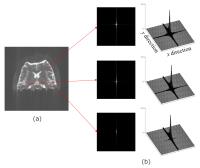 |
Image-based estimation of point spread function in distorted EPI
images
Seiji Kumazawa1, Takashi Yoshiura2,
Akihiro Kikuchi1, Go Okuyama1, Daisuke
Shimao1, and Masataka Kitama1
1Hokkaido University of Science, Sapporo, Japan, 2Kagoshima
University, Kagoshima, Japan
To correct the distortion in EPI due to field inhomogeneity,
the information regarding the signal from adjacent points
within each voxel is needed. The PSF approach can provide
this information. Our purpose was to develop an
image-based-method for estimating the PSF images in the
distorted EPI image using T1WI. Our method synthesizes the
distorted image to match the measured EPI image through the
generation process of EPI image according to a single-shot
EPI k-space trajectory and field inhomogeneity. The results
demonstrate that the PSF image for each voxel in distorted
EPI image can be estimated by proposed method using
segmented T1WI instead of additional acquisitions for PSF
measurement.
|
|
1917.
 |
Combining Multi-channel MP2RAGE Images with Minimized Noise 
Jing Zhang1, Bruce Bjornson2, and
Qing-San Xiang3
1Applied Science Laboratory, GE Healthcare
Canada, Vancouver, BC, Canada, 2Department
of Pediatrics, University of British Columbia, Vancouver,
BC, Canada, 3Department
of Radiology, Department of Physics and Astronomy,
University of British Columbia, Vancouver, BC, Canada
Magnetization-prepared rapid gradient echo (MP-RAGE) has
been widely used for T1-weighted imaging. In
order to overcome B1 field
inhomogeneity effect, the MP2RAGE sequence was introduced,
with two complex images, GRETI1 and
GRETI2, acquired at two inversion times TI1 and
TI2. The MP2RAGE images are usually calculated
from all the coils first and combined later into a final
result. We propose an algorithm for multi-channel MP2RAGE
image combination with minimized resulting noise.
|
|
1918.
 |
Improving the Quality of the Multi-b Diffusion Weighted Images
Using the Intrinsic Multi-Exponential Pattern
He Wang1, Kaining Shi1, Weibo Chen1,
and Guilong Wang1
1Philips Healthcare, shanghai, China, People's
Republic of
The study developed a methodology to improve the quality of
the multi-b DWIs using the intrinsic multi-exponential
pattern. It was evaluated on a healthy brain and compared
with the mono-exponential model. In addition, its potential
value of improving the robustness of IVIM was also
evaluated. According to the results, the multi-exponential
method can improve the image quality of the multi-b DWIs and
may become an effective preprocessing way for the
non-monoexponential models.
|
|
1919.
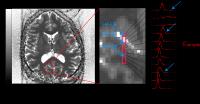 |
Multi-Inversion EPI-based imaging of T1 distribution within
individual voxels
Ville Renvall1 and
Jonathan R. Polimeni2
1Department of Neuroscience and Biomedical
Engineering, Aalto University School of Science, Espoo,
Finland, 2Athinoula
A. Martinos Center for Biomedical Imaging, Department of
Radiology, Massachusetts General Hospital, Harvard Medical
School, Charlestown, MA, United States
T1 mapping using multiple inversion time IR-EPI can provide
a large number of different TI values in a short time, which
can be utilized to characterize the relaxation time
distributions within individual voxels, as an extension to
multi-parametric fitting.
|
|
1920.
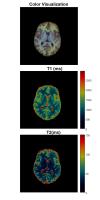 |
Generation of hybrid color images from T1 and T2 acquired
simultaneously with MRF
Katherine L. Wright1, Peter Schmitt2,
Dan Ma1, Anagha Deshmane3, Vikas
Gulani1, and Mark Griswold1
1Radiology, Case Western Reserve University,
Cleveland, OH, United States, 2Siemens
Healthcare, Erlangen, Germany, 3Biomedical
Engineering, Case Western Reserve University, Cleveland, OH,
United States
This work proposes a method for the calculation of a single
color image using quantitative T1 and T2 measurements
acquired with Magnetic Resonance Fingerprinting.
Quantitative MRF parameters are transformed and scaled with
the goal of making normal tissues appear in grayscale and
tissues with different T1 and T2 values (lesions) appear in
color.
|
|
1921.
 |
High-SNR susceptibility weighted venography (SWV) for multi-echo
magnetic resonance (MR) images based on complex signal modeling
Taejoon Eo1, Dosik Hwang1, and
Jinseong Jang1
1Yonsei University, Seoul, Korea, Democratic
People's Republic of
The multi-echo SWV with the proposed complex signal modeling
method can provide high-SNR and multi-contrast phase masks
and SWV images. The multiplication number of the phase mask
for SWV was increased up to 16 without image degradation
even at the long TE of 49.8 ms. More detailed vein
structures were visualized with higher- and multiple
contrasts than the conventional single-echo GRE SWV.
|
|
1922.
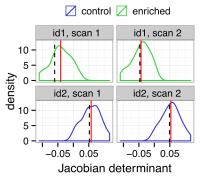 |
Estimating Registration Variance Using Deformation Field
Perturbations
Jan Scholz1, Kaitlyn Easson2, and
Jason P Lerch1,3
1Mouse Imaging Centre, Hospital for Sick
Children, Toronto, ON, Canada, 2Department
of Biomedical and Molecular Sciences, Queen's University,
Toronto, ON, Canada, 3Department
of Medical Biophysics, Department of Medical Biophysics,
Toronto, ON, Canada
Most image registration algorithms do not output any
information about the variance of the transformation
estimates. Here we show that by perturbing input files we
can recover this information without modifying the
underlying algorithms. We demonstrate that local brain
volume estimates can be improved by using the determinant of
the average across the distribution of transformations. Our
methods will improve morphological analyses,
registration-based label alignment, and help find optimal
registration parameters.
|
|
1923.
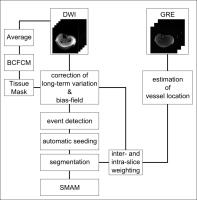 |
Graph-based segmentation of signal voids in time series of
diffusion-weighted images of musculature in the human lower leg 
Martin Schwartz1,2, Günter Steidle1,
Petros Martirosian1, Bin Yang2, and
Fritz Schick1
1Section on Experimental Radiology, Department of
Radiology, University of Tuebingen, Tuebingen, Germany, 2Institute
of Signal Processing and System Theory, University of
Stuttgart, Stuttgart, Germany
The segmentation of signal voids, which occur in time-series
of single-shot diffusion-weighted images, is important for
an accelerated evaluation providing larger studies on this
phenomenon. The proposed segmentation is based on a
two-stage detection and segmentation approach, which
utilizes a graph-based representation with random walker
optimization. It was demonstrated that the presented method
enables a fast and accurate segmentation of signal voids in
time-series of diffusion-weighted images.
|
|
1924.
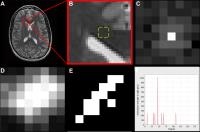 |
Power spectrum detects corpus callosum directionality using
T2-weighted MRI in secondary progressive MS patients and
controls 
Shrushrita Sharma1 and
Yunyan Zhang2
1Biomedical Engineering Program, University of
Calgary, Calgary, AB, Canada, 2Departments
of Radiology and Clinical Neurosciences, University of
Calgary, Calgary, AB, Canada
Standard MRI is routinely collected in patient care but is
limited in assessing changes in tissue microstructure. We
developed a new method to assess tissue directionality using
the power spectrum of T2-weighted MRI and validated it using
the highly coherent structure, corpus callosum. In controls,
power spectrum-derived angles corresponded exactly with the
predicted aligning directions of the corpus callosum, and
such aligning patterns were interrupted in advanced MS
patients with increased variability and angular entropy.
Fourier-based power spectrum may provide advanced measures
of tissue directionality following myelin and axonal
pathology using clinical scans.
|
|
1925.
 |
The Impact of Polar based initialization and frame time curve
selection on Left Ventricle short axis Perfusion MR Segmentation
Doaa Mousa1, Nourhan Zayed1, and Inas
Yassine2,3
1Computer and Systems, Electronic Research
Institute, Giza, Egypt, 2Systems
and Biomedical Engineering, Cairo University, Giza, Egypt, 3Medical
Informatics and Image processing Lab, Nile University, Giza,
Egypt
Cardiovascular diseases (CVDs) cause 31% of the death rate
globally. Automatic accurate segmentation is needed for CVDs
early detection. In this paper, we propose a modified
workflow to automatically segment the left ventricle (LV)
for the short axis cardiac perfusion MRI (perfusion CMR)
images using levelset method. We propose mitigating the
initial contour extraction, and modify the technique used to
initialize the levelset algorithm in order to improve the
accuracy of segmentation results. The system workflow
consists of five main modules: preprocessing, localization,
initial contour extraction, registration, and segmentation.
Our results showed enhancement in the segmentation accuracy
by 5%.
|
|
1926.
 |
Multi-layered Atlas Registrations for Multi-atlas Segmentation
of Brain MRI 
Han Sang Lee1 and
Junmo Kim1
1School of Electrical Engineering, KAIST,
Daejeon, Korea, Republic of
Multi-atlas segmentation has often suffered from the
registration error. We propose a novel method for
multi-atlas registration for multi-atlas segmentation
inspired by the template generation and deep neural network.
We first add an intra-atlas registration layer which
performs image-based registration between atlas images to
duplicate the atlases. We then add a label-wise registration
layer which rectifies the registered images by label-based
registration. We present preliminary results of our
multi-layered atlas registration on brain MRI segmentation.
|
|
1927.
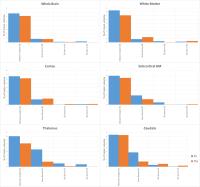 |
The impact of data analysis method, scanner type and scan
session on volume measurements of brain structures
Michael Amann1,2, Pavel Falkovskiy3,4,5,
Alain Thoeni1, Tobias Kober3,4,5,
Alexis Roche3,4,5, Bénédicte Maréchal3,4,5,
Philippe Cattin6, Tobias Heye2, Oliver
Bieri2, Till Sprenger7, Christoph
Stippich2, Gunnar Krueger4,5,8,
Ernst-Wilhelm Radue1, and Jens Wuerfel1
1Medical Image Analysis Center (MIAC), Basel,
Switzerland, 2Department
of Radiology, University Hospital of Basel, Basel,
Switzerland, 3Advanced
Clinical Imaging Technology, Siemens Healthcare AG,
Lausanne, Switzerland, 4Department
of Radiology, University Hospital (CHUV), Lausanne,
Switzerland, 5École
Polytechnique Fédérale de Lausanne, Lausanne, Switzerland, 6Department
of Biomedical Engineering, University of Basel, Basel,
Switzerland, 7Department
of Neurology, DKD Helios Klinik, Wiesbaden, Germany, 8Siemens
Medical Solutions USA, Boston, MA, United States
Performance of FreeSurfer and FSL was compared on
T1-weighted 3D MRI data of 22 controls as function of scan
session, scanner type and segmentation pipeline. Intra-class
correlation coefficients and percentage volume differences
were calculated for the segmentation results of both
pipelines. Strong agreement was found for whole brain, white
matter and cortex. For each pipeline, the impact of
experimental factors was assessed by linear mixed effects
analysis. We found significant scanner effect on the results
of both segmentation pipelines. For subcortical structures,
segmentation reliability was higher in FSL than in
FreeSurfer, whereas for cortex and WM, FreeSurfer was more
stable.
|
|
1928.
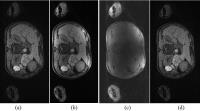 |
Image Inhomogeneity Correction using Geometric Average of
Channels in Sum-of-Squares Multi-channel MR Imaging
Renjie He1, Yu Ding1, and Qi Liu1
1United Imaging Healthcare America, Houston, TX,
United States
Geometric average is insensitive to the value variation
between components to be averaged, this is used to
noticeably reduce the inhomogeneity caused by Sum-of-Squares
(SOS) in channel combination in parallel MR imaging.
|
|
1929.
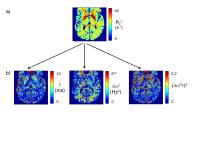 |
In-vivo characterization of grey matter microstructure at
3T from the transverse component of the MRI signal
Antoine Lutti1
1LREN, Dept. of Clinical Neurosciences, Centre
Hospitalier Universitaire Vaudois, Lausanne, Switzerland
The characterization of brain microstructure from MRI data
requires the development of specific MRI tissue biomarkers
and of advanced models linking microscopic tissue properties
to MRI signals. We apply the Anderson-Weiss theory, which
describes the transverse relaxation of the MRI signal as a
function of tissue microstructure, on in-vivo MRI data
acquired at 3T. In grey matter, parameter estimates show a
strong correlation with histological measures of iron
concentration. The time constants provided by the model
yield realistic estimates of microscopic compartment size.
These results offer a promising perspective for the
histological assessment of brain tissue in-vivo using MRI.
|
|
1930.
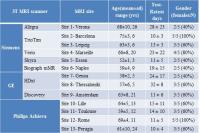 |
Hippocampal subfields segmentation derived from Freesurfer 6.0:
a multisite 3T reproducibility study in healthy elderly
Moira Marizzoni1, Daniele Orlandi1,
Luigi Antelmi2, Flavio Nobili3, Mira
Didic4,5, David Bartrés-Faz6, Ute
Fiedler7, Peter Schonknecht8, Pierre
Payoux9,10, Andrea Soricelli11,12,
Alberto Beltramello13, Lucilla Parnetti14,
Magda Tsolaki15, Paolo Maria Rossini16,17,
Pieter Jelle Visser18, Regis Bordet19,
Oliver Blin20, Giovanni Battista Frisoni1,21,
Jorge Jovicich22, and on behalf of the PharmaCog
Consortium1
1LENITEM Laboratory of Epidemiology,
Neuroimaging, & Telemedicine — IRCCS San Giovanni di
Dio-FBF, Brescia, Italy, 2Health
Department, Foundation IRCCS Neurological Institute Carlo
Besta, Milan, Italy,3Department of Neuroscience,
Ophthalmology, Genetics and Mother–Child Health (DINOGMI),
University of Genoa, Genoa, Italy, 4APHM,
CHU Timone, Service de Neurologie et Neuropsychologie,
Marseille, France,5Aix-Marseille Université,
INSERM U 1106, Marseille, France, 6Department
of Psychiatry and Clinical Psychobiology, Universitat de
Barcelona and IDIBAPS, Barcelona, Spain, 7LVR-Clinic
for Psychiatry and Psychotherapy, Institutes and Clinics of
the University Duisburg-Essen, Essen, Germany, 8Department
of Neuroradiology, University Hospital Leipzig, Leipzig,
Germany, 9INSERM,
Imagerie cérébrale et handicaps neurologiques, UMR 825,
Toulouse, France, 10Université
de Toulouse, UPS, Imagerie cérébrale et handicaps
neurologiques, UMR 825, CHU Purpan, Place du Dr Baylac,
Toulouse, France, 11IRCCS
SDN, Naples, Italy,12University of Naples
Parthenope, Naples, Italy, 13Department
of Neuroradiology, General Hospital, Verona, Italy, 14Section
of Neurology, Centre for Memory Disturbances, University of
Perugia, Perugia, Italy, 153rd
Department of Neurology, Aristotle University of
Thessaloniki, Thessaloniki, Greece, 16Dept.
Geriatrics, Neuroscience & Orthopaedics, Catholic
University, Policlinic Gemelli, Rome, Italy, 17IRCSS
S.Raffaele Pisana, Rome, Italy, 18Department
of Neurology, Alzheimer Centre, VU Medical Centre,
Amsterdam, Italy, 19Department
of Pharmacology, EA1046, University of Lille Nord de France,
Lille, Italy, 20Pharmacology,
Assistance Publique-Hôpitaux de Marseille, Aix-Marseille
University-CNRS UMR 7289, Marseille, France, 21Memory
Clinic and LANVIE - Laboratory of Neuroimaging of Aging,
University Hospitals and University of Geneva, Geneva,
Switzerland, 22Center
for Mind/Brain Sciences, University of Trento, Rovereto,
Italy
In this study we quantify the across-session reproducibility
of hippocampus subfields obtained from the recently proposed
ex-vivo atlas tool available in Freesurfer version 6.0. We
use structural 3T multisite data from 65 healthy elderly
participants scanned twice at least a week apart. We show
that several subfields like Cornu Ammonis (CA) 1,
hippocampal tail, molecular layer and subiculum offer,
despite being smaller, comparable reliability errors to the
whole hippocampus volume (2%). This suggests that these
subfields may be valid and more specific markers to test
disease progression in longitudinal studies, like for
example Alzheimer's disease.
|
|
1931.
 |
Identification of Microbleeds on Postmortem Brain of Normal
Aging Elderly and Dementia Patients
Shunshan Li1, Lily Zhou2, Mark J
Fisher3, Ronald C Kim4, Vitaly
Vasilevko5, David Cribbs5, Annlia Hill3,
and Min-Ying Su6
1Tu & Yuen Center for Functional Onco-Imaging,
Department of Radiological Sciences, university of
california, irvine, irvine, CA, United States, 2Sun
Yat-Sen Memorial Hospital, Sun Yat-Sen University,
Guangzhou, China, People's Republic of, 3Department
of Neurology, University of California, Irvine, Irvine, CA,
United States, 4Department
of Pathology, University of California, Irvine, Irvine, CA,
United States, 5Institute
for Memory Impairments and Neurological Disorders,
University of California, Irvine, irvine, CA, United States, 6Tu
& Yuen Center for Functional Onco-Imaging, Department of
Radiological Sciences, University of California, Irvine,
irvine, CA, United States
The postmortem brain MR images include air-bubble artifacts
and typical microbleeds(MBs) are less than 200 µm which make
MBs detection very challenging. In this project we developed
an optimization MR imaging method to detect possible MBs on
postmortem brains of patients with and without dementia,
hoping to provide information to guide neuropathological
examination to sample the suspicious MBs areas, and improve
the chance of identifying true MBs to better understand its
role in normal aging and development/progression of
dementia, and further develop streamlined automatic MBs
detection software.
|
|
1932.
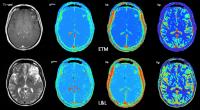 |
Dynamic Contrast Enhanced MRI Measurements in Glioma: Comparison
Between Two Models
Sameeha Fallatah1, Rolf Jäger1, and
Xavier Golay1
1Brain Repair and Rehabilitation, UCL, Institute
of Neurology, London, United Kingdom
Dynamic Contrast Enhanced MRI is used to assess the
integrity of the blood brain barrier. A major difficulty for
the method to be accepted in the clinics is the variety of
pharmacokinetic models used and their strong dependence on
the underlying assumptions and/or acquisition parameters.
Thus the far simpler methods based on signal intensity curve
characteristics are the most commonly used approaches in
clinical practice. In this study we compare two different
pharmacokinetic models, the extended Tofts model and
Lawrence & Lee model in patients with primary brain
tumours.
|
|
1933.
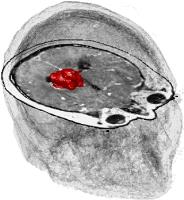 |
Development and Implementation of a Matlab-based multi-modal 3D
visualization, co-registration and quantification platform for
assessing brain tumor physiology and metabolism
Gaurav Verma1, Suyash Mohan1, Sanjeev
Chawla1, John Y.K. Lee2, Sumei Wang1,
Andrew Maudsley3, Steven Brem2, and
Harish Poptani4
1Department of Neuroradiology, University of
Pennsylvania, Philadelphia, PA, United States, 2Department
of Neurosurgery, University of Pennsylvania, Philadelphia,
PA, United States, 3Department
of Radiology, University of Miami, Miami, FL, United States, 4Department
of Cellular and Molecular Physiology, University of
Liverpool, Liverpool, United Kingdom
A 3D visualization, co-registration and quantification
platform was developed in Matlab to combine anatomical
imaging with physiological and metabolic data from diffusion
tensor, perfusion-weighted and echo-planar spectroscopic
imaging. This data can be co-registered across modalities
and imaging time-points to provide detailed information
about the spatial extent of a brain tumor. 3D visualization
was applied in datasets from patients undergoing
neurosurgery and a separate cohort of patients undergoing
long-term Tumor Treating Fields (TTFields) therapy. This
visualization platform could have an impact in the planning
of neurosurgery and the placement and monitoring of
location-sensitive techniques like TTFields.
|
|
1934.
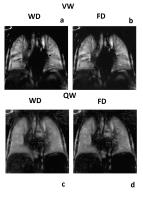 |
Non-Contrast-Enhanced Perfusion and Ventilation Assessment of
the Human Lung by Means Of Wavelet Decomposition in Proton MRI
David Bondesson1,2, Thomas Gaass1,3,
Julien Dinkel1,2, and Berthold Kiefer4
1Josef Lissner Laboratory for Biomedical Imaging,
Department of Clinical Radiology,
Ludwig-Maximilians-University Hospital Munich, Munich,
Germany, 2Comprehensive
Pneumology Center, German Center for Lung Research, Munich,
Germany, 3Comprehensive
Pneumology Center,German Center for Lung Research, Munich,
Germany, 4Siemens
AG Healthcare Sector, Erlangen, Germany
Evaluating regional lung perfusion and ventilation is
diagnostically valuable in regards of pulmonary diseases.
Standard methods however, expose patients to risks from
ionizing radiation and contrast agents. MRI screening is not
based on radiation and a new method has previously been
presented as a non-contrast-enhanced estimation. This work
presents wavelet decomposition as a potential improvement to
fourier decomposition for perfusion and ventilation
assessment of the human lung in proton MRI.
|
|
1935.
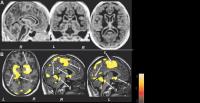 |
Regional Brain Tissue Entropy Assessment in Patients with
Obstructive Sleep Apnea
Sudhakar Tummala1, Bumhee Park1, Ruchi
Vig1, Mary A Woo2, Daniel W Kang3,
Ronald M Harper4,5, and Rajesh Kumar1,5,6,7
1Anesthesiology, University of California at Los
Angeles, Los Angeles, CA, United States, 2UCLA
School of Nursing, Los Angeles, CA, United States, 3Medicine,
University of California at Los Angeles, Los Angeles, CA,
United States, 4Neurobiology,
University of California at Los Angeles, Los Angeles, CA,
United States, 5Brain
Research Institute, University of California at Los Angeles,
Los Angeles, CA, United States, 6Radiological
Sciences, University of California at Los Angeles, Los
Angeles, CA, United States, 7Bioengineering,
University of California at Los Angeles, Los Angeles, CA,
United States
Obstructive sleep apnea subjects show gray matter volume
loss in multiple brain areas, based on voxel-based
morphometry procedures, which are less sensitive in
detecting subtle chronic/acute gray or white matter changes.
We assessed brain injury in recently-diagnosed, treatment
naïve OSA subjects by evaluating regional entropy, which
measures the extent of homogeneity or randomness in tissue
texture, and found significantly decreased regional entropy
values in areas regulating autonomic, respiratory,
cognitive, and neuropsychologic functions
that are deficient in the condition, suggesting
predominantly acute tissue pathology in those sites.. The
findings suggest that regional entropy can demonstrate acute
tissue changes.
|
|
1936.
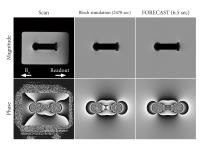 |
Fast simulation of off-resonance artifacts in MRI using FORECAST
(Fourier-based Off-REsonanCe Artifact Simulation in the
STeady-State) 
Frank Zijlstra1, Job G Bouwman1, Ieva
Braškute1, and Peter R Seevinck1
1Image Sciences Institute, UMC Utrecht, Utrecht,
Netherlands
We present a fast alternative to Bloch simulation for
simulation of off-resonance artifacts in steady-state
imaging. By assuming a steady-state, the signal equation can
be quickly evaluated by using multiple Fast Fourier
Transforms. We show an acceleration factor of over 350 for a
2D simulation of a titanium cylinder phantom, while the
differences with Bloch simulation were minor. The speed of
the proposed method enables 3D simulations at high
resolution and may benefit various applications.
|
|
1937.
 |
Estimation of voxel-wise phase offsets in a phased array coil
using multi-echo GRE data 
Minju Jo1, Yoonho Nam2, Jeehun Kim1,
Hyeong Geol Shin1, and Jongho Lee1
1Laboratory for Imaging Science and Technology,
Department of Electrical and Computer Engineering, Seoul
National University, Seoul, Korea, Republic of, 2Department
of Radiology, Seoul St. Mary's Hospital, College of
Medicine, The Catholic University of Korea, Seoul, Korea,
Republic of
In this work, we present a method of estimating the phase
offsets in multi-echo GRE data, Multi-Channel Phase
Combination using all N echoes (MCPC-N). MCPC-N, which
calculates the phase offsets from all echoes, provides more
accurate estimation of voxel-wise phase offsets particularly
in low SNR.
|
|
1939.
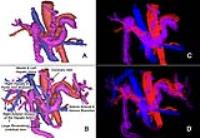 |
Optimized 4D flow MRI Processing for Evaluation of Abdominal
Blood Flow 
Eric James Keller1, Jeremy Douglas Collins1,
Cynthia K Rigsby2, James C Carr1,
Michael Markl1,3, and Susanne Schnell1
1Radiology, Northwestern University, Chicago, IL,
United States, 2Radiology,
Ann & Robert H. Lurie Children's Hospital of Chicago,
Chicago, IL, United States, 3Biomedical
Engineering, Northwestern University, Evanston, IL, United
States
4D flow MRI quantification of abdominal hemodynamics is
challenged by a wide range of blood flow velocities and
vessel diameters. By adjusting critical pre-processing steps
required to analyze 4D flow MRI data, we were able to both
recover vessels of interest lost by our previous method and
significantly reduce the relative error in flow
measurements. We conclude that it is critical to apply
background phase error correction prior to any other filters
and/or corrections to ensure accurate background offset
estimation. Additionally, low venc acquisitions should not
be noise corrected to ensure low flow data is not
inadvertently deleted.
|
|
1938.
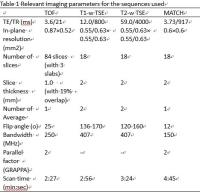 |
Characterization of atherosclerotic carotid plaque using MATCH
with histopathologic validation: initial clinical experience 
Lixin Yang1, Wei Yu1, Zhaoyang Fan2,
and DeBiao Li3
1Department of Radiology, Beijing AnZhen
Hospital, Beijing, China, People's Republic of, 2Biomedical
Imaging Research Institute, Cedars-Sinai Medical Center, Los
Angeles, CA, United States, 3Biomedical
Imaging Research Institute, Cedars-Sinai Medical
Center,Department of Bioengineering, University of
California, Los Angeles, CA, United States
Purpose: Determine the accuracy of MATCH in the
characterization of plaque composition in patients in
comparison with the conventional multi-contrast approach,
using histopathology as the gold standard. Methods:
Twenty-two patients scheduled for carotid endarterectomy
underwent preoperative carotid MRI with MATCH and the
conventional protocol, blinded image review for composition
identification was performed by 2 radiologists. Carotid
histopathological specimens stained with HE and Masson,
matched with this two protocol images, Cohen kappa (K) was
computed to quantify the agreement in the detection of
components among this two protocols and histopathology.
Results: Moderate to good agreement was seen between
histopathological specimens and multi-contrast protocol in
the detection of plaque components (IH k=0.704 , CA k=0.763,
LR/NC k=0.844). Similar results were seen between
histopathological specimens and MATCH (IH k=0.703CA k=0.740,
LR/NC k=0.850).
|
|
1940.
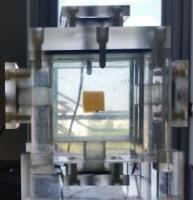 |
MRI-SPAMM Based Magnetic Resonance Electrical Impedance
Tomography 
Kemal Sümser1, Nashwan Naji1,2, Mehdi
Sadighi1, Hasan Hüseyin Eroglu1,3, and
Murat Eyüboglu1
1Electrical and Electronics Engineering
Department, Middle East Technical University, Ankara,
Turkey, 2On
Leave from Ibb University, Ibb, Yemen, 3TSK
Rehabilitation and Care Center, Ankara, Turkey
In
magnetic resonance electrical impedance tomography (MREIT)
currents are injected to the object during MRI imaging
sequence. In this study, we propose a new pulse sequence
based on the spatial modulation of magnetization (SPAMM) to
be used in MREIT applications. In this pulse sequence, the
current is injected during a pre SPAMM module which can be
followed by any conventional Magnetic Resonance Imaging
pulse sequence for data acquisition. Experimental result in
comparison with the simulation result shows
that this method is an applicable technique for MREIT data
acquisition.
|
|
1941.
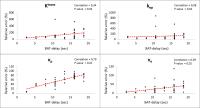 |
The Influence of Bolus Arrival Time in Pharmacokinetic Analysis
of Dynamic Contrast-Enhanced MRI of Breast Masses 
Endre Grøvik1,2, Atle Bjørnerud1,2,
Tryggve Holck Storås1, Kjell-Inge Gjesdal3,
and Kathinka Dæhli Kurz4
1The Intervention Centre, Oslo University
Hospital, Oslo, Norway, 2Department
of Physics, University of Oslo, Oslo, Norway, 3Sunnmøre
MR klinikk AS, Ålesund, Norway, 4Department
of Radiology, Stavanger University Hospital, Stavanger,
Norway
The purpose was to evaluate the influence of BAT in
pharmacokinetic analysis of breast masses, by estimating the
kinetic parameters both with and without BAT-delay
correction. Thirty-nine verified breast masses were examined
using a high temporal resolution EPI sequence. The
image-data were analyzed using a two-compartment kinetic
model with and without BAT-delay correction. The
relationship between the relative parametric error and
BAT-delay were investigated. The result indicates that
neglecting the delayed BAT leads to an overestimation of Ktrans,
kep, and, ve, and a underestimation of
vp, and that the delayed BAT needs to be
accounted for in the model-based analysis.
|
|
